He did the crime, he did the time, and then he disappeared – again.
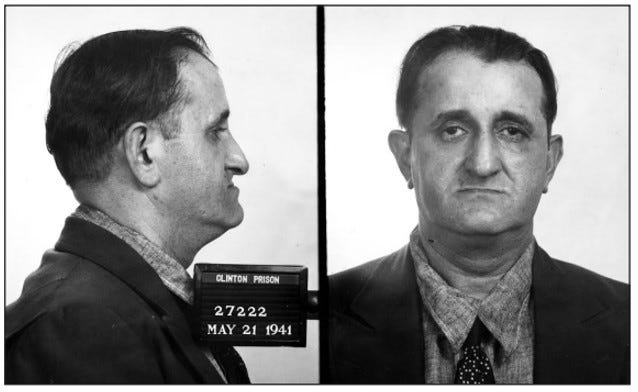 Harry Pincus mug shots (New York Department of Correction as seen in Walloomsick Review 22)
Harry Pincus mug shots (New York Department of Correction as seen in Walloomsick Review 22)
I should have known better when I decided to write an article about Barry Manilow’s Irish roots. As an Irish American fanilow, I wanted to know which town or city could lay claim to him (shout-out to Limerick!), but that’s not where the real story was – or where 80% of my research effort went. I only made it as far as his grandmother, Anna “Annie” Sheehan, before getting derailed when I accidentally tripped into a retro, true crime tale featuring a central character who disappeared.
When Harry Met Annie
A New York-born child of Irish immigrants, Annie married young, seemingly to escape a floundering household, but it turned out to be a fire-to-the-frying-pan situation. At the age of 16, she wed Harry Pincus, the son of Russian immigrants, at Brooklyn Borough Hall.
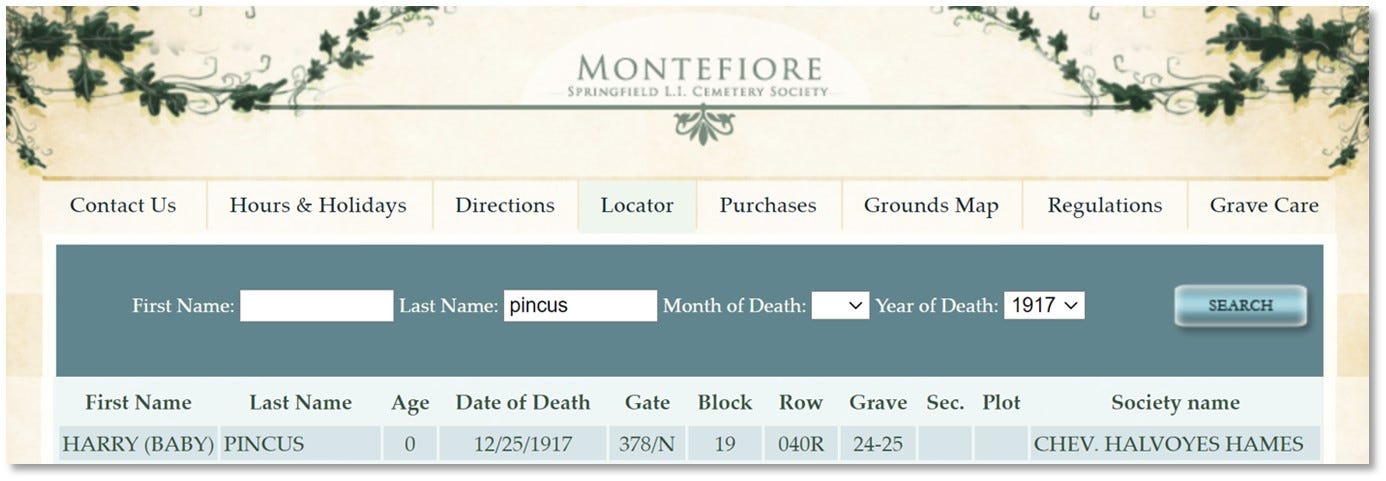
Burial of baby Harry Pincus, Montefiore Cemetery
Two months later, their son – also named Harry – was born, and just two weeks later, he died. The young couple buried their first born on Christmas day at a Jewish cemetery.
Somehow, they soldiered on. Their second child, Harold, was born in 1920. He would spend life as an only child, just as his future son – Barry Manilow – would.
About this time, Annie’s husband began venturing from their Brooklyn home. His brothers moved to Pittsfield, Massachusetts where they would establish themselves in the glass and automotive businesses, and he joined them – sort of. Though Pittsfield was his home base, he worked largely as a salesman and was said to have spent long stretches of time on the road. He also had a side hustle that occasionally kept him away from home – one hinted at by this photo of him with a woman believed to be Annie.
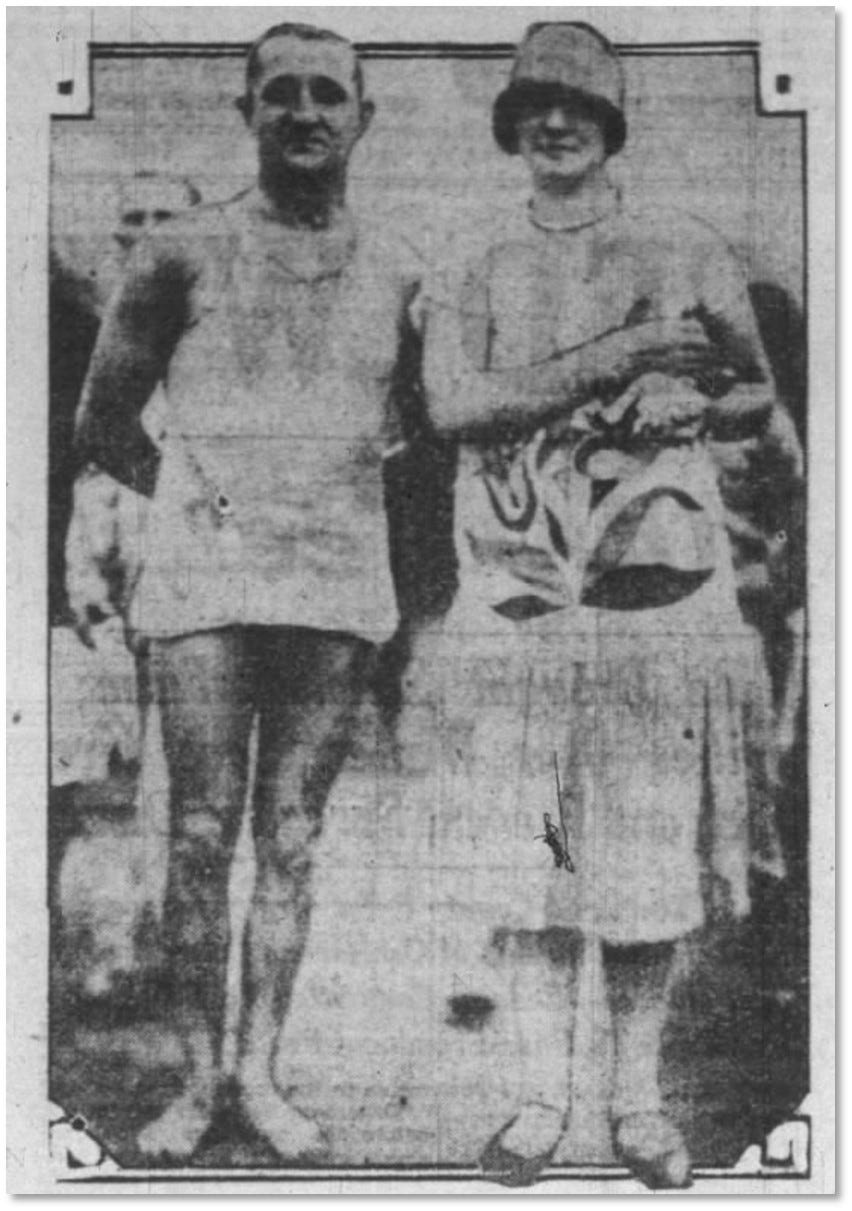
Berkshire Evening Eagle, 15 August 1930 (Newspapers)
You may have noticed that he’s attired in swimming garb of the day, but I doubt you guessed why. Harry was a strong man, but a very specific kind. Most of the stunts he did involved swimming long distances (one to two miles was typical) while pulling – with a rope in his teeth – up to five rowboats with men in them. He was even known to occasionally do this with his arms tied behind his back.

Boston Globe, 10 July 1922 (Newspapers)
It’s clear that Annie and Harry were together in Pittsfield – at least until 1928. That’s when the local city directory notes them as having moved away, and all indications are that this is when they began to drift apart. By the time of the 1930 census, Annie and her son Harold were living on their own back in Brooklyn and she’s recorded as being divorced. It was easy to follow the two of them forward in time, but what had happened to Harry?

1928 Pittsfield, MA city directory (Ancestry)
Where’s Harry?
Harry was one of several men of his name born in New York around the mid-1890s, so while I found some candidates when looking for him in census records, I wasn’t convinced of any of them. How could I be sure? Then I turned up a 1941 prison admission for a Harry Pincus of roughly his vintage. Hmm. Maybe?
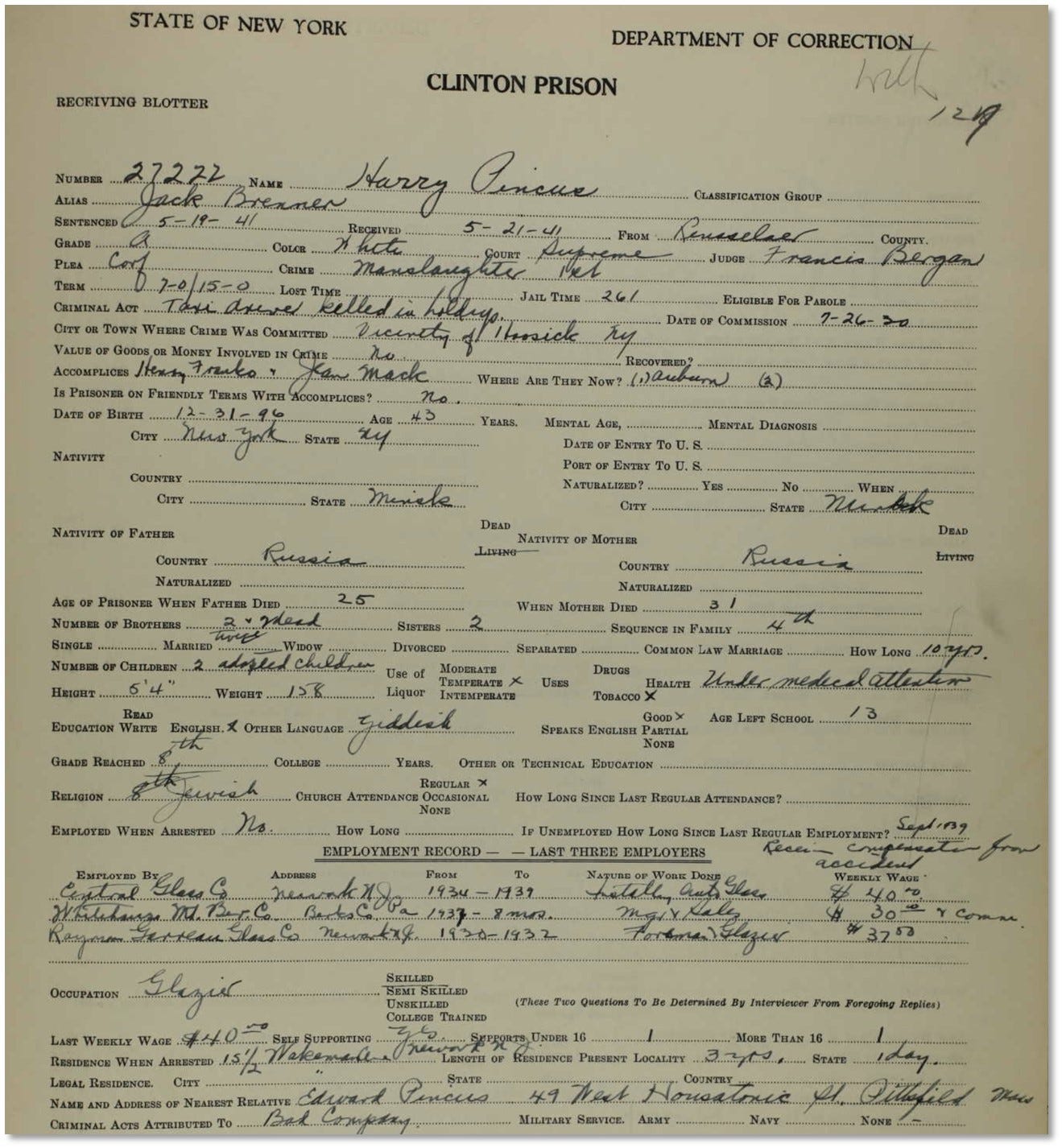
New York, Clinton Prison Admission Ledgers (Ancestry)
I drilled down into the specifics, and thanks to his parents’ names being mentioned in the paper trail from his marriage to Annie Sheehan, had already researched his parents and siblings. The prison record was slightly cryptic. It didn’t, for instance, name his parents, but stated how old he was when each of them died – 25 for his father and 31 for his mother. Yes, that mapped with what I had. And it didn’t list his siblings, but indicated that he had four brothers (two living and two deceased) and two sisters, and that he was the fourth born. I couldn’t account for one of the deceased brothers (perhaps one died young), but otherwise, this was a good fit.
Then I noticed that he had been married twice, the last time ten years ago. And he had two adopted children. Since I had lost track of him, I made a mental note to get back to this.
Further down the page, I saw that he had held three jobs over the last decade – two in Newark, New Jersey and one in Berks County, Pennsylvania. That might be helpful to know, so I tucked this away in my memory bank as well.
Finally, at the bottom of the page, he designated his next of kin: Edward Pincus in Pittsfield, Massachusetts. Yes, this was one of his brothers. Now I knew for sure that this was the Harry Pincus I was looking for.
Based on his swimming stunt days, Harry was clearly a showman, so I figured he had pulled off some confidence scam or fraud, but when I scanned back up the page, I was startled to see that he was in prison for manslaughter. He and two others were involved in the killing of a taxi driver during a holdup near Hoosick, New York back in 1930.
Manslaughter? And more than a decade ago? I had to know more, so decided to explore a handful of online newspaper sites.
Mike Kane’s Murder
On the evening of July 26, 1930, 42-year-old Michael Kane of Bennington, Vermont, was murdered. A dashing Irish immigrant who liked to flash cash and diamond rings, he had been a boxer in his younger days, but now worked as a taxi driver. The launching of his taxi business roughly coincided with the introduction of Prohibition, so some believed he was involved with alcohol smuggling.
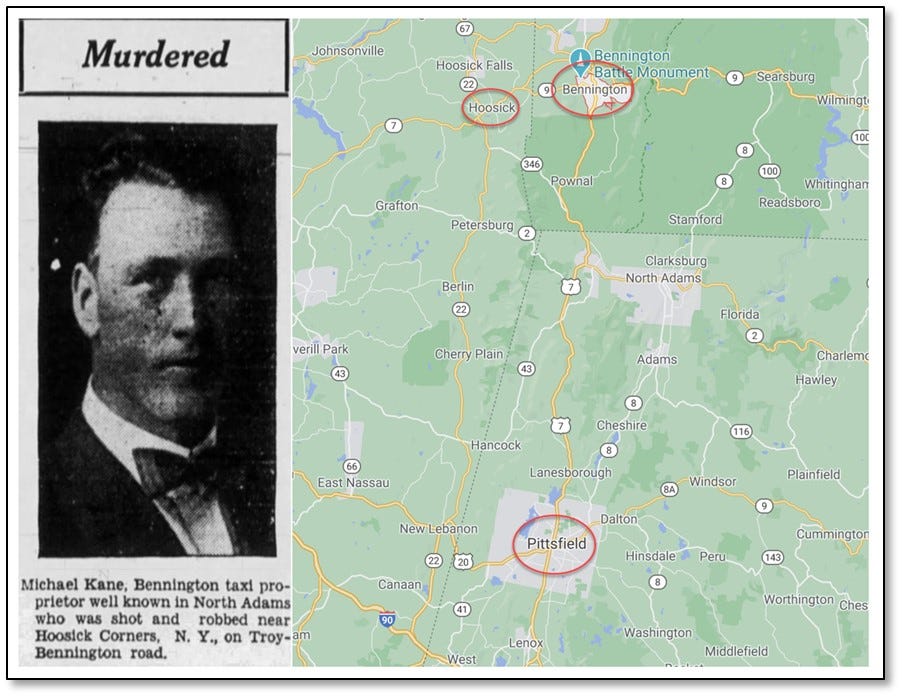
North Adams Transcript, 28 July 1930 (Newspapers) and (Google Maps)
On that day, Kane was hired by an unknown man for a ride to Troy, New York, and whether he knew it or not, they were followed by another car with two people, Harry Pincus and a woman then known as Jean Mack. It would later be learned that Pincus ran in some of the same circles as Kane, knew of his ostentatious habits, and suggested him as the trio’s target.
When Kane’s car neared a lightly trafficked area along the way, the passenger – a man named William Franco – shot and bludgeoned him before managing to get the car to the side of the road. With Pincus and Mack parked nearby feigning car trouble and serving as lookouts, Franco robbed the victim.
The murder took place near Hoosick, just across the Vermont-New York border and roughly 35 miles north of Pittsfield, Massachusetts where Harry used to live. If you were to venture to the area today, you’d still be able to spot it as there’s a marker saying, “Mike Kane was killed here by unknown assassin.” The friend who initially put it in place didn’t live long enough for the perpetrators to be brought to justice, but that process would soon grind into motion thanks in part to Pincus himself. The few who came across the pulled-over cars around the time of the crime had been “encouraged” by him to keep moving, and one couple, surprised by his brusque response to their offer of help, noted his license plate.

Berkshire Eagle, 30 August 1930 (Newspapers)
Harry’s Lucky Break
Within days, police identified and charged Harry Pincus as being an accessory to Mike Kane’s murder, and due to his notoriety as a swimming strong man, they had fliers with his likeness. Wanted posters were widely distributed as it was believed he would flee the area, if he hadn’t already.
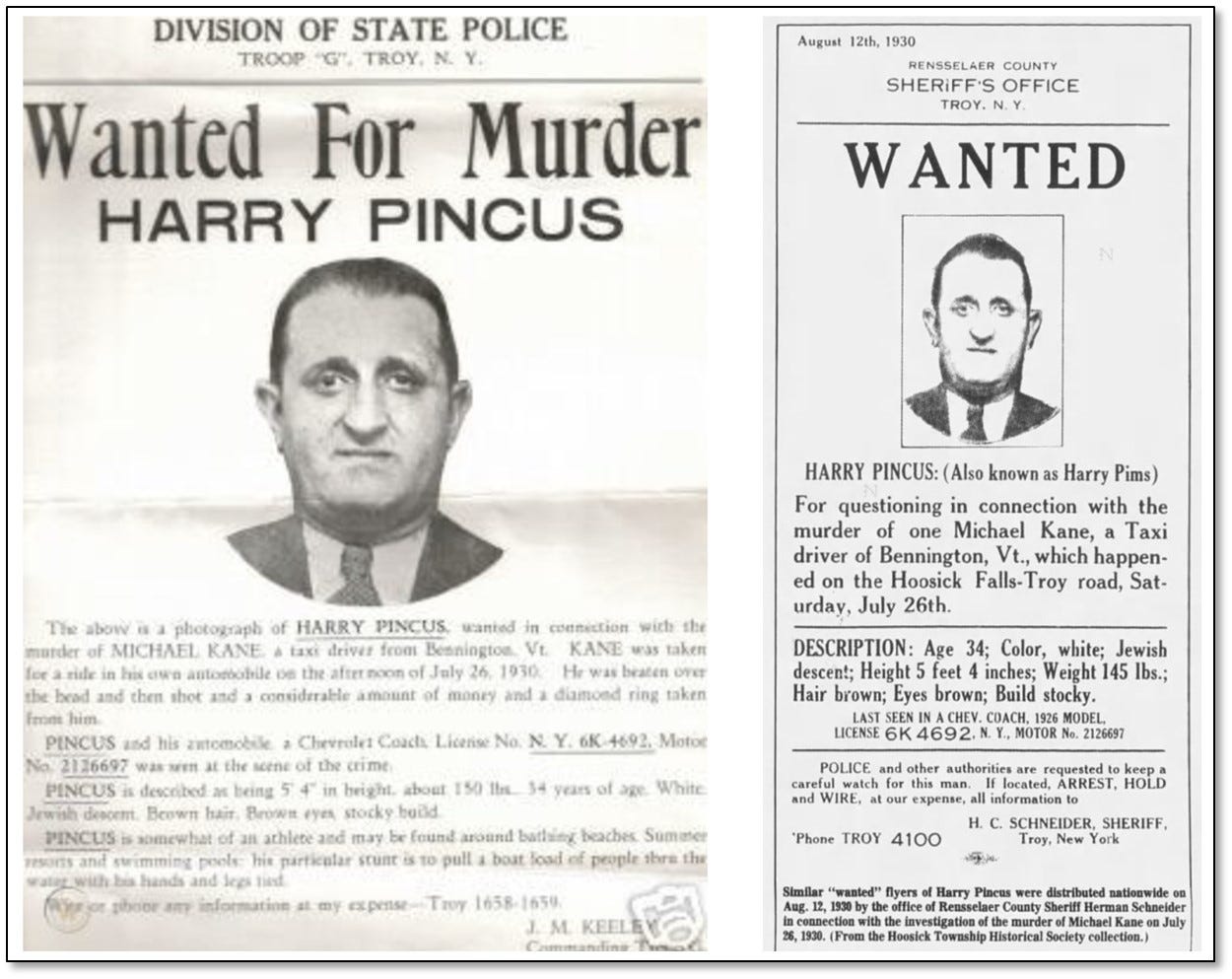
Worthpoint and Washington County Post, 15 April 1987 (Newspapers)
But hopes for a swift resolution dimmed when Pincus caught the most extraordinary of breaks – a case of mistaken identity that worked in his favor. Another Harry Pincus, about the same age as Manilow’s future grandfather, had grown up in Hoosick Falls near the scene of the crime. Though he had moved away, he happened to be vacationing in the vicinity when the murder took place. Police swooped in on him, only to determine they had the wrong man, but as a result of this episode, many latched on to the belief that “Harry Pincus” was an alias assumed by the criminal and not his real name.

Bennington Evening Banner, 31 July 1930 (Newspapers)
Where’d They Go?
Before long, the genuinely named Harry Pincus and his partners in crime vanished, and it wasn’t until 1936 that police received a promising tip. William Franco and Jean Mack had been a couple, and when Franco dumped her for another woman, Mack was overheard during a weepy, venting session in a Brooklyn bar. While lamenting all she had done for him, she mentioned the murder. An informant told the police and she and Franco were arrested.
Though often overlooked, local history publications can be invaluable, and “Shedding new light on the Michael Kane murder case” by Warren F. Broderick (Walloomsack Review, Vol 15, Spring 2015) provides an entertaining and meticulously researched accounting of this case including what happened next, but since we’re focused on Harry Pincus, I’ll briefly summarize what became of the others before returning to him.
Franco was convicted and sentenced to death, but received a commutation to life in prison from the governor of New York. He was eventually paroled in the 1960s and died in 1982. Jean Mack would skate thanks to the testimony she gave, and then disappear again. But her troubled life followed her and she resurfaced – literally – in the waters of the Hudson River as a murder victim herself in 1948. Her last beau would prove to be her killer.
Harry’s Luck Boomerangs
Several years after the trial, an article about the Kane case – “Murder Clue of the Jilted Blonde” – appeared in Headline Detective magazine and included Pincus’s photo. A Newark patrolman read the article and brought it to the attention of Luke Conlon, an officer who had worked on the case in New York before transferring to Newark. Conlon dug out Pincus’s wanted poster. When the photo made the rounds, someone noticed that Pincus looked like a man named Jack Brenner who worked at a glass factory with a relative. No doubt the mention of a glass factory must have excited Conlon since the Pincus brothers had been in this business in Pittsfield.
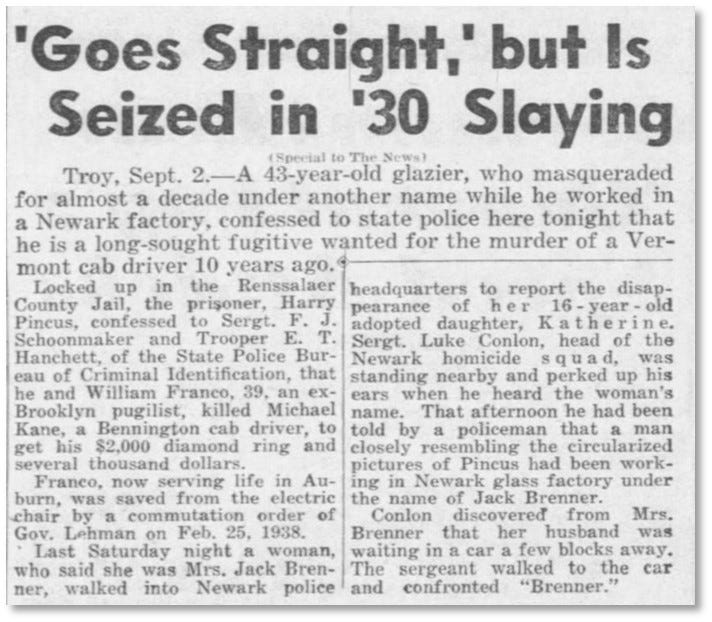
Daily News, 3 September 1940 (Newspapers)
Later that same day, a woman identifying herself as Mrs. Brenner walked into Newark police headquarters to report her adopted 16-year-old daughter, Catherine, as missing. Conlon heard “Brenner,” asked where her husband was, and was led to their car. That the couple was in Newark was a fluke because “Jack Brenner” had a serious accident involving a head injury the previous year so the family had escaped from the bustle of the city to his father-in-law’s place in Berks County, Pennsylvania to aid with his recovery. They had come back for medicine and to report their missing daughter. It would later be discovered that “Brenner” had installed glass at several Newark police stations.
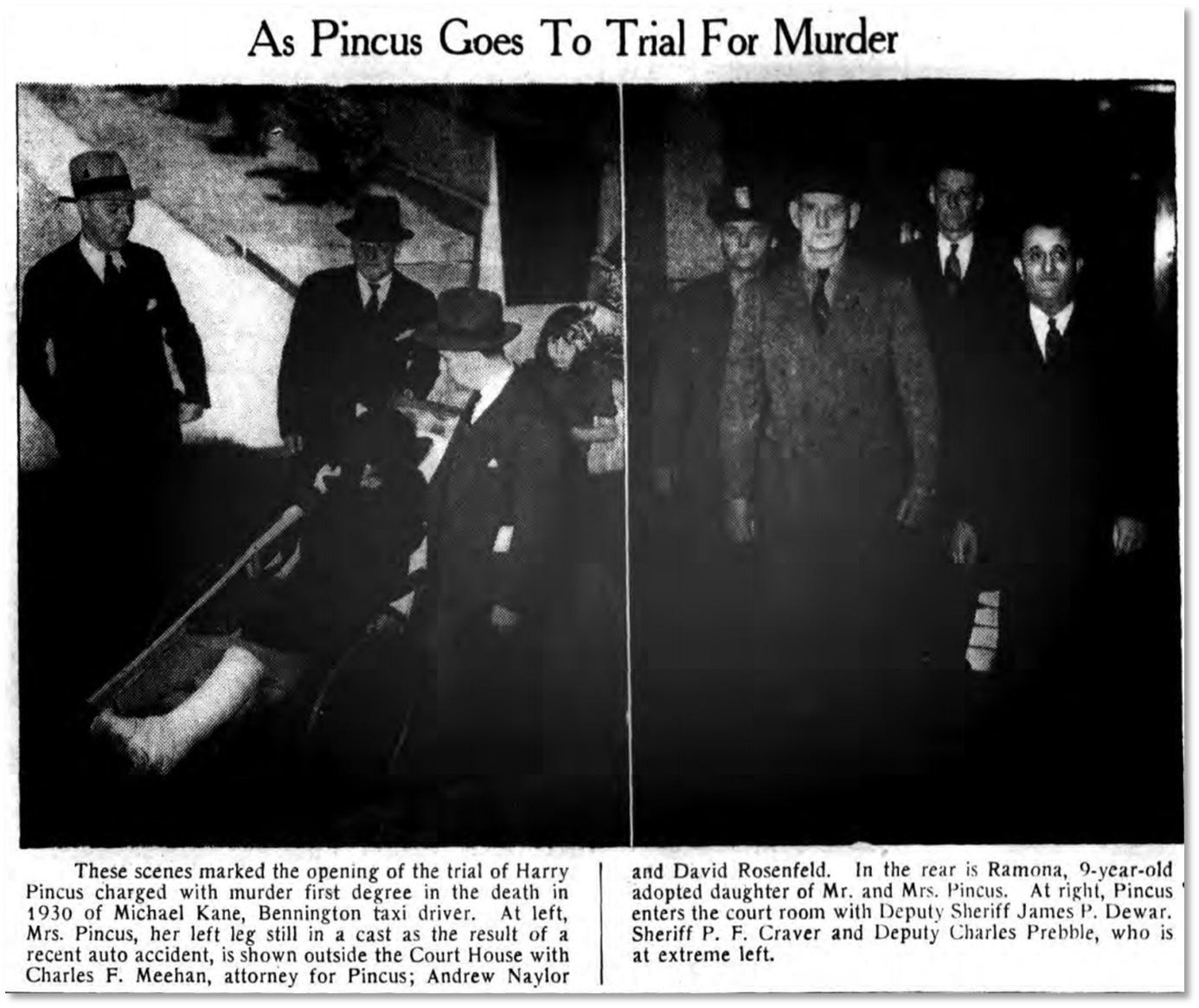
The Times Record, 14 May 1941 (FultonHistory)
All of this came as a shock to Mrs. Brenner who had married “Jack” almost a decade earlier. Pincus denied any role in Kane’s killing, but went peacefully with police to Troy, New York. But the drama didn’t end there.
While on her way to visit her husband in jail, Mary Brenner/Pincus was in a car accident that left her badly injured, thus delaying the trial. When it was rescheduled, she showed up in court in a wheelchair with one of her legs in a cast and a second adopted daughter, Ramona, aged nine. Mary was camera-shy, so the image above is the only one I was able to ferret out, and though it’s blurry, Ramona can also be seen.
Perhaps it was the sudden reappearance of Jean Mack (still seven years shy of her own murder) to testify or the wish to minimize the impact on his family, but Jack/Harry changed his plea to guilty. Taking into account his seeming rehabilitation – a decade of living as a working, devoted family man with a pair of adopted daughters – Harry Pincus was sentenced to 7.5 to 15 years in Clinton Prison.
Where’s Harry? (Take 2)
It was Harry’s prison registration that had sent me spiraling into this research tunnel in the first place, but I still had a few questions and I wasn’t the only one. Warren F. Broderick, writer of the excellent local history article mentioned earlier, was also left wondering. And I suspect Barry Manilow might be curious too.

excerpt from “Shedding new light on the Michael Kane murder case”
by Warren F. Broderick (Walloomsack Review, Vol 15, Spring 2015)
As Broderick noted, Harry Pincus was paroled in 1945, but no one knew what had become of him after. Some believed that he returned to his family in either New Jersey or Pennsylvania, but this was a lingering mystery. How could I trace him?
There was the question of whether he still went by Harry Pincus after he left prison, and as seen earlier, even if he had, the name isn’t as rare as some might think, so I wasn’t surprised to find several candidates for him in assorted death indexes.
I began my quest by seeking any additional documents that might be available, starting with his 1940 census under his alias of Jack Brenner in Newark. There was his unsuspecting wife, Mary, and their adopted daughter, Catherine, whose running away would spark his rediscovery. Mary, I noticed, was born in Florida. This might be useful as it was an unusual birth place for someone in the Northeast back then. I scratched my head about the absence of the other daughter, Ramona since this census was taken just months before Harry would be arrested. She was in some newspaper accounts and he claimed two adopted children in his prison entry record, so where was she?

1940 census (Ancestry)
Next, I found his World War II draft registration card. Though he was in prison, he still had to register. His date of birth was December 31, 1896 which differed from the January 1, 1896 date he had given in his draft registration for World War I, and he had somehow acquired a middle name of William, but such inconsistencies were common at the time, and I knew he was the right fellow since he was in Clinton Prison. Harry also gave his non-prison address as 3218 Gray Street in Laureldale, Pennsylvania, a fact that caught my attention because I had seen this Berks County town mentioned in newspaper articles associated with his wife’s family.
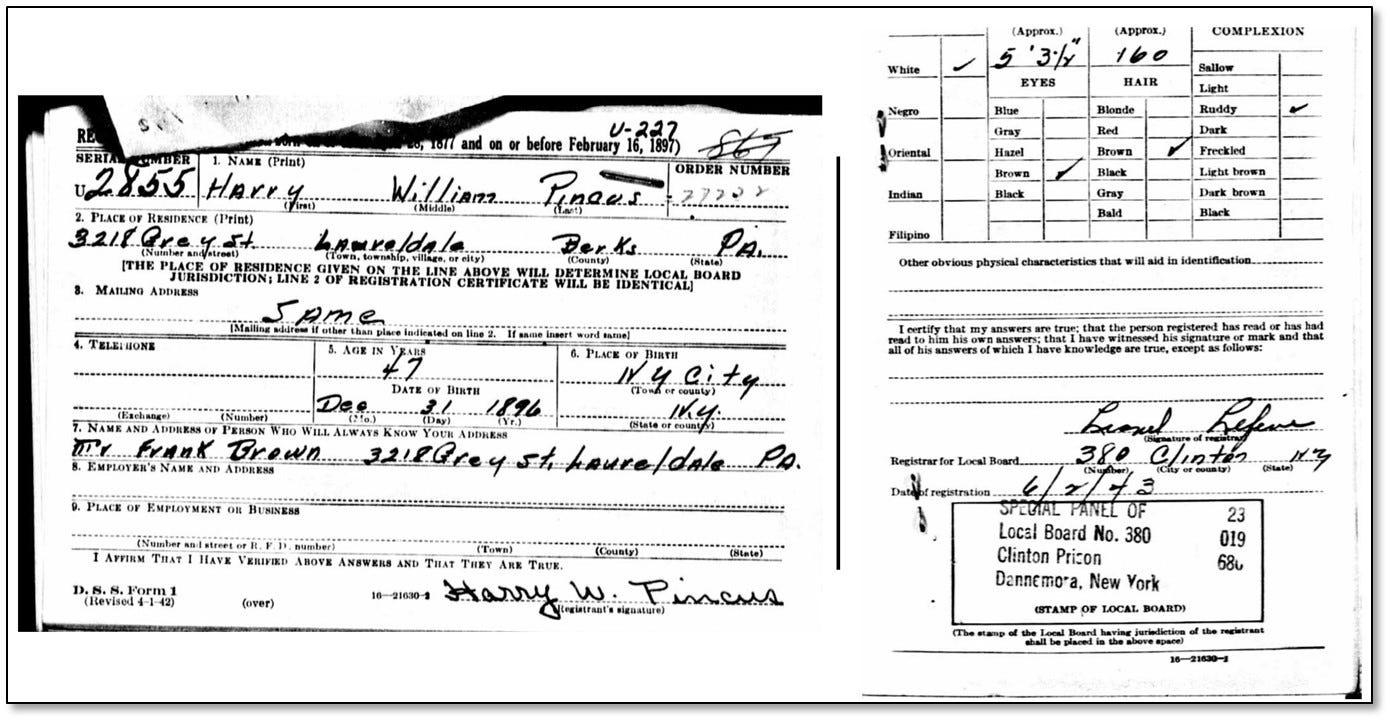
WWII draft registration (Ancestry)
The man listed as a “person who will always know your address” was Frank Brown, so I looked him up in the 1940 census, and there he was with his family at the same address. Two details jumped out. Like Harry’s wife Mary, he was also born in Florida. Could this be a brother of Mary’s, a brother-in-law of Harry’s? I also noticed that Frank was recorded as being Indian.
This triggered a deep dive into the Brown family and resulted in the conclusion that yes, this was the family of Harry’s second wife, Mary. Some strange conflicts emerged. Though the basics of the family were steady (i.e., names, birth sequence, ages, etc.), it wasn’t until 1930 that anyone claimed to have been born in Florida. Prior to that, South Carolina was the usual response. And over the years, family members were logged as Black, mulatto, Indian, and white. Given that they turned out to originally be from South Carolina, it’s possible that they moved north as part of the Great Migration and decided to pass, but while this was interesting, it didn’t help answer questions about Harry, so I moved on.
I was, however, intrigued to learn that Mary and Harry’s adopted daughters were her niece (Catherine) and half-sister (Ramona). I found Ramona, the “daughter” who appeared with Mary in court in May 1941, in the 1940 census with her actual parents. Mary had stayed there to recuperate from her accident, and it was inconvenient that the niece she and Harry had raised had gone AWOL, so she had apparently borrowed a sibling for court. Harry’s second adopted child was really his sister-in-law who was raised by her own parents, so there had been a bit of staging for the trial.
Almost There
Equipped with all these new snippets of information, and hoping that he kept going by Harry W. Pincus after he was released, I spotted a possible marriage in Brooklyn. The bride? Mary Brenner. The coincidence was too much to ignore. So Harry W. Pincus had returned to the Brooklyn haunts of his youth and remarried his second wife. Of course, he would have had no clue that he had a young grandson named Barry – still a Pincus at the time – living just a few miles away.
For the final stretch, I returned to the death index entries I had gathered for men named Harry Pincus. After ruling out several, I turned to a fellow who had died in Brooklyn on June 13, 1958, but he was only 58 when I would have expected a man in his early 60s. Still, I decided to take a look at the Social Security death index listing for him.
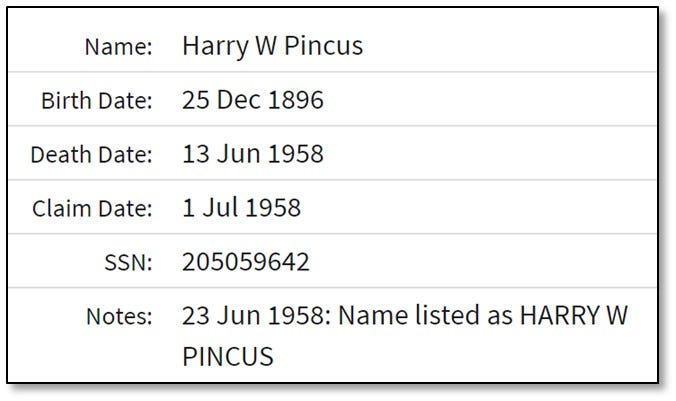
Ah, Harry W. Pincus. And he was born in 1896, not 1900 as the other index stated. I laughed when I saw the exact date. This was the Harry I was coming to know. While his birth date changed from record to record, it was always a day of celebration – New Year’s Day, New Year’s Eve, and now, Christmas.
I was confident this was him, but a genealogist always wants proof, so I sent off for some documents that – shudder – do not exist online. Nevertheless impatient, I brainstormed for any evidence I wouldn’t have to wait for. Yes, his Social Security number. I decoded it, and discovered that it had been issued in Pennsylvania. Social Security launched in 1936, and the job history on his prison intake form told me that he was living and working in Berks County, Pennsylvania in 1937. A bit more sleuthing allowed me to eliminate all the other Pennsylvanians and New Yorkers who shared his name.
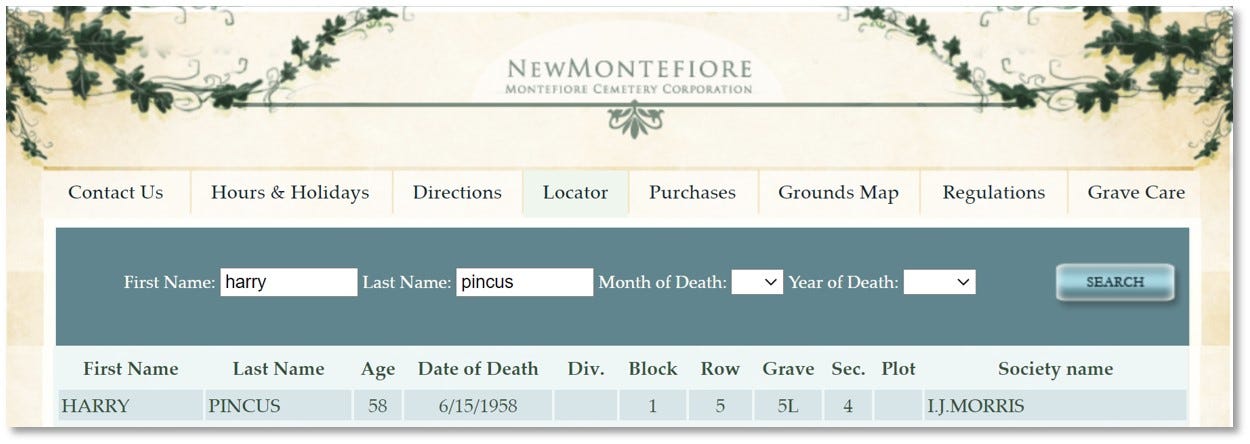
Burial of Harry Pincus, New Montefiore Cemetery
Curious where the final resting place of Harry W. Pincus was, I conducted one last search and located him in another portion of the same cemetery where Harry Pincus, his infant namesake son, had been buried four decades earlier. As much as he had strayed, Barry Manilow’s grandfather still found a way to come home.

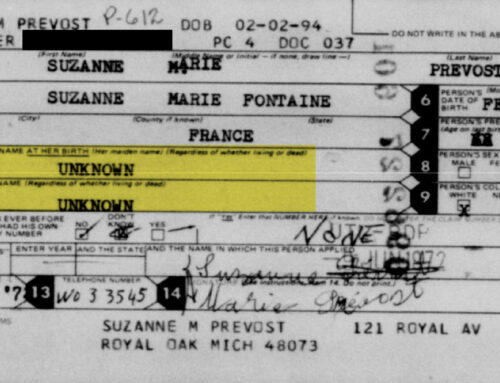
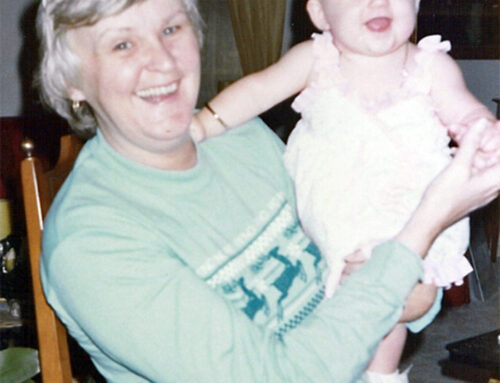
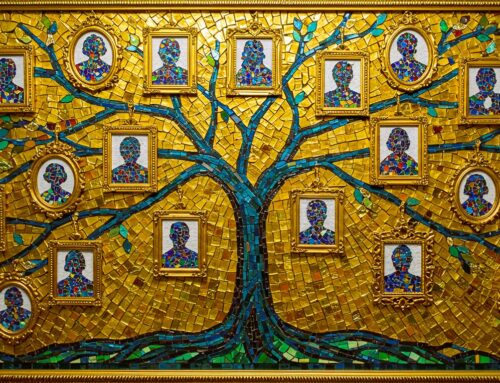

Leave A Comment